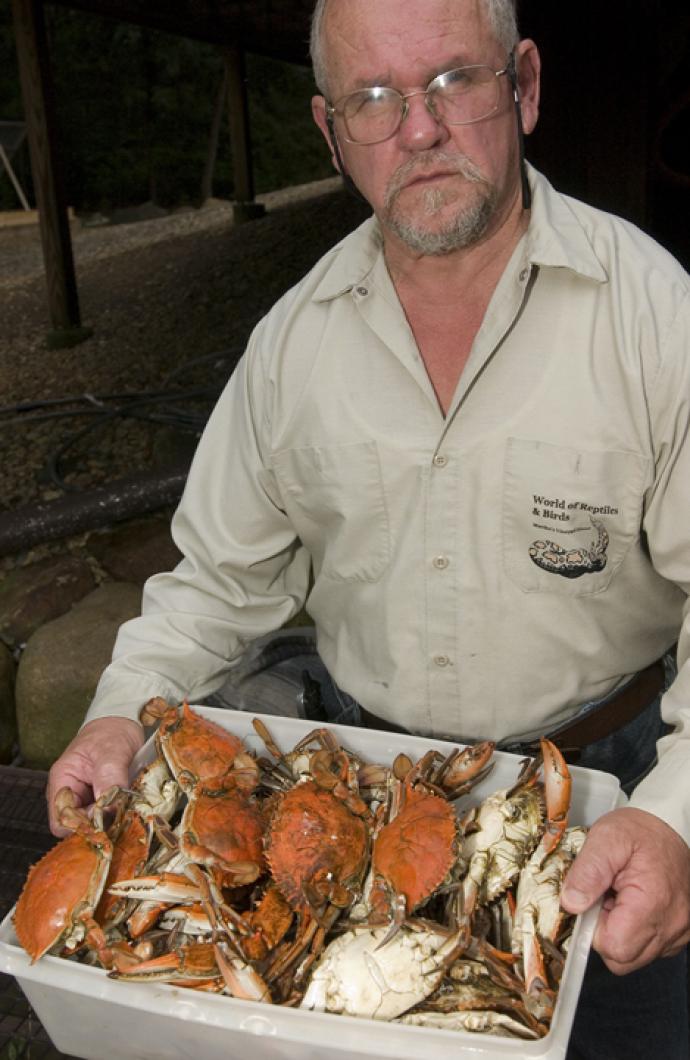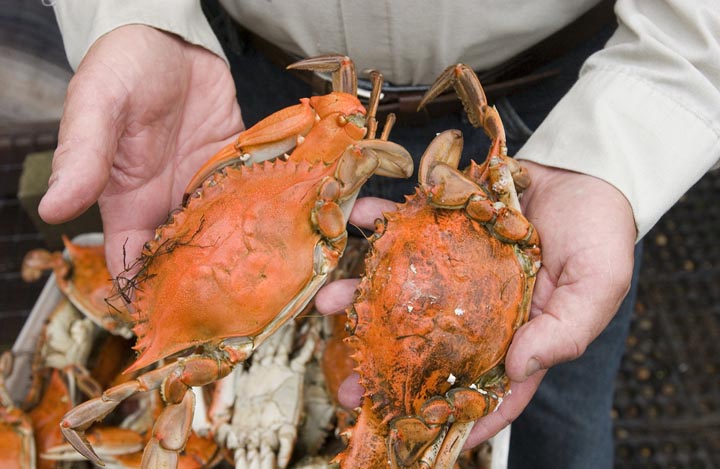Blue crab is a Vineyard seafood delicacy. For many years, the idea of eating blue crab here was kept quiet among those who knew where to find them. They were the Vineyard’s secret seafood.
But increasing awareness of the health of the Island’s great ponds has moved the topic above a whisper; the only secret now is where.
This is a great summer for the harvesting of blue crabs, many people on the water are talking about it. Local blue crab is more flavorful than lobster, although it requires more work to get that morsel of delicious meat.
Children with nets have been spotted at Trapp’s Pond culvert to Sengekontacket. And little crab fishermen have been spotted walking around the Bass Creek in Vineyard Haven. Edgartown and Tisbury Great Ponds are reportedly in the thick of a good season. If you are a swimmer in any of the great ponds, be careful where you step in the water.
On Monday night, Gus Ben David, of Edgartown and his son Shane went crab fishing at the end of a busy August day. It was more than a hunt and more than a father and son outing, it was a return to a family ritual. They chose just before sunset and dusk.
Mr. Ben David grew up on the Island. He runs the World of Reptiles and Birds Park and is a former director of the Felix Neck Wildlife Sanctuary.
As a youth he spent a lot of time on the water and in the woodlands. Harvesting blue crabs remains a cherished memory for him. In those days, the ponds were full of the crabs and there was far less concern of overfishing and water quality than there is now.
“They were abundant. I remember blue crabs in Farm Pond. I remember them being thick in the eelgrass at the First Bridge [little bridge]. There, the eelgrass was so thick on the bottom you couldn’t run your outboard through it, cause it would foul the propeller.
“Blue crab fishing was just like all the other things we did in those days, blueberry picking, and beach plum picking,” Mr. Ben David said.
The technique for attracting the animals was simple, but it took skill to get them in the bucket. “We fished in the daylight, there were so many of them,” Mr. Ben David recalled.
Before trekking to the shoreline, Mr. Ben David remembers members of his family going to Marshall’s Fish Market in Oak Bluffs and picking up the discarded heads of bluefish and striped bass.
“In those days we took the head of a fish and tied it to a string,” Mr. Ben David said. The heads were tossed into the water. While standing on the shore, Mr. Ben David recalled “ever so gently” pulling in the line. It took real skill to scoop the crabs into a handheld net before they could scurry away. “Oh, those crabs were fast in the daylight,” Mr. Ben David recalled.
These days the fishermen go out at night with a flashlight, sometimes using pieces of raw chicken tied to a string. There is a state-imposed bag limit of 25 crabs per day and a minimum size for the head of five inches. The length of the head is the measurement from spine to spine.
Fishermen are not allowed to harvest egg-bearing females, for obvious reasons.
When it comes to eating and serving, you are on your own.
Mr. Ben David recalls his aunt Alvira Ben David. “She was great. She’d take us all out to get the blue crabs and then we’d have them for supper,” Mr. Ben David said.
She would bring the pot for cooking to a boil. Then the crabs were dumped in. It usually took about 20 minutes for the water to come back to a boil; the crabs, now bright orange, would be done.
The meal involved taking the dining room table, or kitchen table, and covering it with newspapers. The pot would occupy the center of the table and the eating would begin. It was a messy meal, but in a summer of eating it was one of the most satisfying ones.
Getting the crab meat out of the animal was an art, Mr. Ben David said. Those who were good at it got the most.
The reason blue crab fishing descended from a fairly popular hunt to one that is done in the quiet, Mr. Ben David said, has to do largely with access to private property and the availability of the animal from summer to summer.
The crabs aren’t always in abundance, and when they are, they are fairly easy to overfish.
Overfishing is a loose term to describe their availability after one fisherman has filled his bucket. There will never be enough blue crabs in Island ponds to feed the potential interest.
Those who have permission from private landowners cherish and value their opportunity.
“It is like the derby fishermen. They don’t tell where they got their big fish,” Mr. Ben David said.
There is plenty unknown about why blue crabs can be so abundant in one year and disappear another. “They are an enigma,” he said.
Once every couple of years, Mr. Ben David said there are huge offshore blue crabs that come into the pond for some unknown reason when there is a pond opening to the sea. “They are huge. You’ve never seen crabs that big,” he said. He believes those crabs are the ones that will stay in the pond over the winter.”
Bill Wilcox of the Martha’s Vineyard Commission is helping with a Woods Hole-funded study of blue crabs in the great ponds. The study is being done by Luanne Johnson and Eva Faber, a student in the Island school system. They are trying to study the movement of the crabs in the two great ponds.
“We know a lot about the blue crabs in the Chesapeake Bay,” Mr. Wilcox said, but there is little known about the crabs in these two Vineyard ponds.
State environmental police Sergeant Matthew Bass said the blue crab fishery is pretty quiet; incidents are rare. “It generally doesn’t create a lot of complaints,” he said.
When it comes to inspecting the fisherman’s catch for size and number, Sergeant Bass said he is deterred from being “by the bxxxxxxxxook.”
“I’ve gotten my hands pinched enough, enough to draw blood,” he said.







Comments
Comment policy »